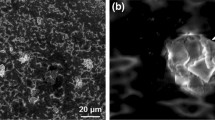Abstract
The thermal expansion coefficient (TEC) of nano-B4C having 50 nm mean particle size was measured as a function of applied direct current (DC) electric field strength varying from 0 to 12.7 V/mm and over a temperature range from 298 K up to 1273 K. The TEC exhibits a linear variation with temperature despite being measured over a range that is well below 50% of B4C’s normal melting temperature. The zeroth- and first-order TEC coefficients under zero-field condition are 4.8220 ± 0.009 × 10−6 K−1 and 1.462 ± 0.004 × 10−9 K−1, respectively. Both TECs exhibit applied DC electric field dependence. The higher the applied field strength, the steeper the linear thermal expansion response in nano-B4C, which suggests that the applied field affects the curvature of the interatomic potentials at the equilibrium bond length at a given temperature. No anisotropic thermal expansion with and without applied electric field was observed, although nano-B4C has a rhombohedral unit cell symmetry. The rhombohedral unit cell angle was determined as δR = 65.7046° (0.0007), and it remains unaffected by a change in temperature and applied electric field strength, which we attribute to B4C nanoparticle size and its carbon saturation.







Similar content being viewed by others
References
C. Kittel: Introduction to Solid State Physics, 8th ed. (John Wiley & Sons, New York, NY, 2005).
R.E. Newnham: Properties of Materials (Oxford University Press, Oxford, U.K., 2005).
V. Domnich, S. Reynaud, R.A. Haber, and M. Chhowalla: Boron carbide: Structure, properties, and stability under stress. J. Am. Ceram. Soc. 94, 3605–3628 (2011).
R.A. Andrievski: Micro- and nanosized boron carbide: Synthesis, structure and properties. Russ. Chem. Rev. 81, 549–559 (2012).
N. Vast, J. Sjakste, and E. Betranhandy: Boron carbides from first principles. J. Phys.: Conf. Ser. 176, 012002 (2009).
A.K. Suri, C. Subramanian, J.K. Sonber, and T.C. Murthy: Synthesis and consolidation of boron carbide: A review. Int. Mater. Rev. 55, 4–40 (2010).
C. Wood and D. Emin: Conduction mechanism in boron carbide. Phys. Rev. B 29, 4582 (1984).
B. Matchen: Applications of ceramics in armor products. Key Eng. Mater. 122, 333–344 (1996).
L. Vargas-Gonzalez, R.F. Speyer, and J. Campbell: Flexural strength, fracture toughness, and hardness of silicon carbide and boron carbide armor ceramics. Int. J. Appl. Ceram. Technol. 7, 643–651 (2010).
D. Emin and T.L. Aselage: A proposed boron-carbide-based solid-state neutron detector. J. Appl. Phys. 97, 013529 (2005).
W.K. Barney, G.A. Sehmel, and W.E. Seymour: The use of boron carbide for reactor control. Nucl. Sci. Eng. 4, 439–448 (1958).
B.D. Cullity: Elements of X-ray Diffraction, 2nd ed. (Adisson-Wesley Publishing, USA, 1978).
T.L. Aselage and R.G. Tissot: Lattice constants of boron carbides. J. Am. Ceram. Soc. 75, 2207–2212 (1992).
F. Thevenot: Boron carbide—A comprehensive review. J. Eur. Ceram. Soc. 6, 205–225 (1990).
A. Lipp: Boron Carbide: Production, Properties, and Applications, Battelle Northwest Laboratories, NTIS Issue Number 197013, 1970.
T.R. Pilladi, G. Panneerselvam, S. Anthonysamy, and V. Ganesan: Thermal expansion of nanocrystalline boron carbide. Ceram. Int. 38, 3723–3728 (2012).
O. Guillon, J. Gonzalez-Julian, B. Dargatz, T. Kessel, G. Schierning, J. Räthel, and M. Herrmann: Field-assisted sintering technology/spark plasma sintering: Mechanisms, materials, and technology developments. Adv. Eng. Mater. 16, 830–849 (2014).
U. Anselmi-Tamburini, Z.A. Munir, Y. Kodera, T. Imai, and M. Ohyanagi: Influence of synthesis temperature on the defect structure of boron carbide: Experimental and modeling studies. J. Am. Ceram. Soc. 88, 1382–1387 (2005).
D. Yang, R. Raj, and H. Conrad: Enhanced sintering rate of zirconia (3Y-TZP) through the effect of a weak dc electric field on grain growth. J. Am. Ceram. Soc. 93, 2935–2937 (2010).
E.K. Akdoğan, İ. Şavklıyıldız, H. Biçer, W. Paxton, F. Toksoy, Z. Zhong, and T. Tsakalakos: Anomalous lattice expansion in yttria stabilized zirconia under simultaneous applied electric and thermal fields: A time-resolved in situ energy dispersive X-ray diffractometry study with an ultrahigh energy synchrotron probe. J. Appl. Phys. 113, 233503 (2013).
T.J.B. Holland and S.A.T. Redfern: Unit cell refinement from powder diffraction data: The use of regression diagnostics. Mineral. Mag. 61, 65–77 (1997).
Y. Waseda, E. Matsubara, and K. Shinobada: X-ray Diffraction Crystallography (Springer, New York, 2011).
J.F. Nye: Physical Properties of Crystals (Oxford University Press, Oxford, U.K., 1985).
M.M. Balakrishnarajan, P.D. Pancharatna, and R. Hoffmann: Structure and bonding in boron carbide: The invincibility of imperfections. New J. Chem. 31, 473 (2007).
H.L. Yakel: Lattice expansions of two boron carbides between 12 and 940 °C. J. Appl. Crystallogr. 6, 471 (1973).
M. Born and K. Huang: Dynamical Theory of Crystal Lattices (Clarendon Press, Wotton-Under-Edge, 1998).
C. Haines, E.K. Akdoğan, and T. Tsakalakos. Private communication (2019).
R.L. Snyder: The Rietveld Method, R.A. Young, ed. (Oxford University Press, New York, NY, 1993); pp. 111–131.
Jade (Materials Data Inc., Livermore, California, 2019).
Acknowledgments
The authors wish to express their gratitude for the financial support provided by the Office of Naval Research (ONR) under Contract Nos. N00014-10-1-042 and N00014-17-1-2087, Sub-Award No. 4104–78982 from Purdue. The authors wish to thank Dr. Antti Makinen and Dr. Larry Kabacoff of the ONR for their valuable technical feedback. This research was carried out in part at the NSLS, which is supported by the U.S. Department of Energy, Division of Material Sciences, and Division of Chemical Sciences, under Contract No. DE-AC02-06CH11357. H.B. and İ.Ş. acknowledge the financial support from the Ministry of Education of the Turkish Republic.
Author information
Authors and Affiliations
Corresponding author
Rights and permissions
About this article
Cite this article
Biçer, H., Akdoğan, E.K., Şavklıyıldız, İ. et al. Thermal expansion of nano–boron carbide under constant DC electric field: An in situ energy dispersive X-ray diffraction study using a synchrotron probe. Journal of Materials Research 35, 90–97 (2020). https://doi.org/10.1557/jmr.2019.382
Received:
Accepted:
Published:
Issue Date:
DOI: https://doi.org/10.1557/jmr.2019.382




